BUS226 Talent Acquisition Report: Selection Tools for HAYS Recruitment
VerifiedAdded on 2023/01/11
|15
|3049
|43
Report
AI Summary
This report analyzes effective selection tools for the HAYS organization, specifically focusing on the graduate recruitment consultant role. It begins with an executive summary, introduction, and then delves into the main body, which examines various selection tools like skill assessments, screening, background checks, personal interviews, and drug testing. The report then critically analyzes the interview selection tool and skill assessment and test selection tool for the HAYS organization. It provides detailed recommendations for improving the selection process, including incorporating digital technologies for interviews and ensuring fairness and validity in assessments. The report concludes by summarizing the key findings and emphasizing the importance of selecting the right tools to acquire the best talent. Appendices include interview schedules, skill assessment checklists, and job descriptions.

RESERCH REPORT
Paraphrase This Document
Need a fresh take? Get an instant paraphrase of this document with our AI Paraphraser
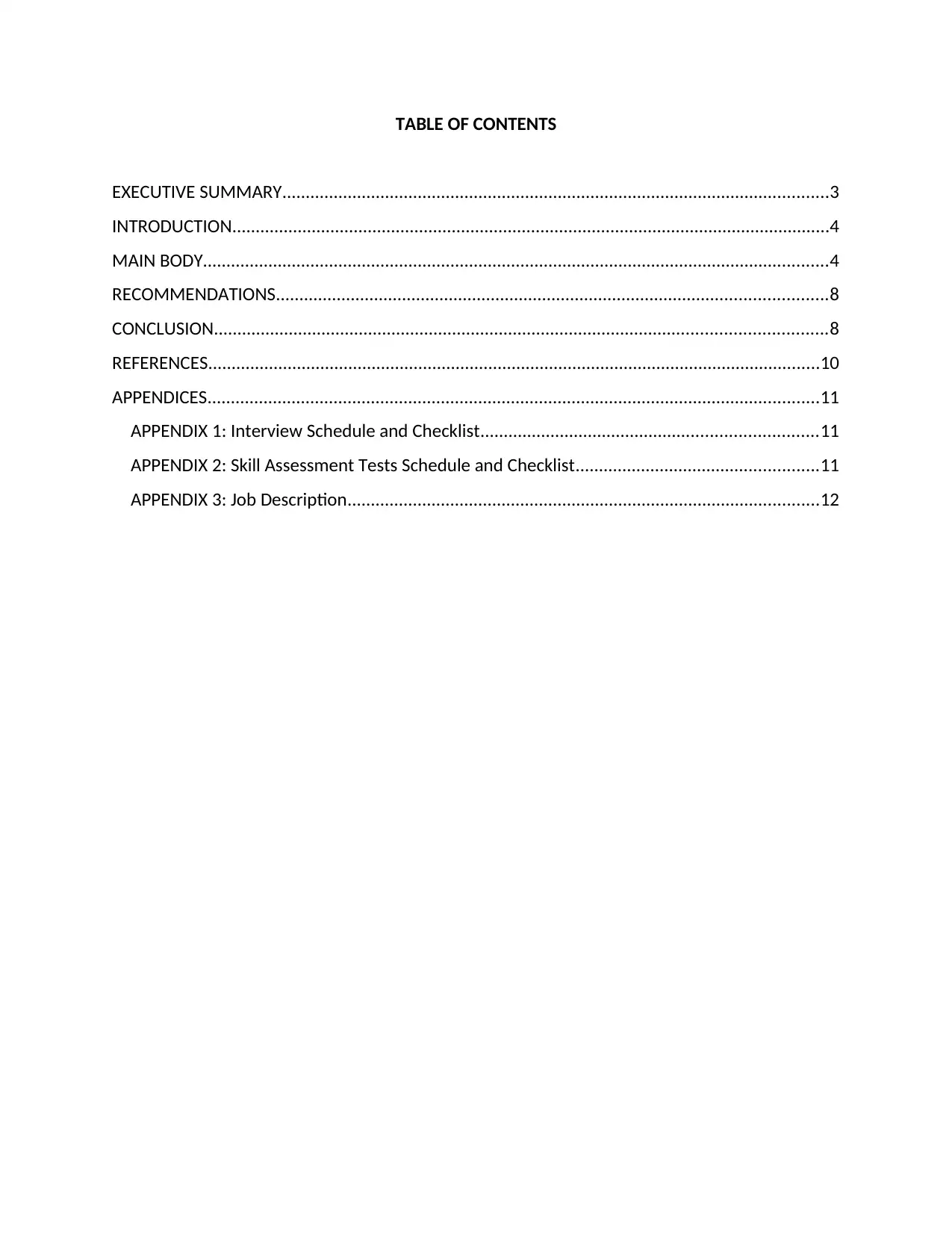
TABLE OF CONTENTS
EXECUTIVE SUMMARY.....................................................................................................................3
INTRODUCTION................................................................................................................................4
MAIN BODY......................................................................................................................................4
RECOMMENDATIONS......................................................................................................................8
CONCLUSION...................................................................................................................................8
REFERENCES...................................................................................................................................10
APPENDICES...................................................................................................................................11
APPENDIX 1: Interview Schedule and Checklist........................................................................11
APPENDIX 2: Skill Assessment Tests Schedule and Checklist....................................................11
APPENDIX 3: Job Description.....................................................................................................12
EXECUTIVE SUMMARY.....................................................................................................................3
INTRODUCTION................................................................................................................................4
MAIN BODY......................................................................................................................................4
RECOMMENDATIONS......................................................................................................................8
CONCLUSION...................................................................................................................................8
REFERENCES...................................................................................................................................10
APPENDICES...................................................................................................................................11
APPENDIX 1: Interview Schedule and Checklist........................................................................11
APPENDIX 2: Skill Assessment Tests Schedule and Checklist....................................................11
APPENDIX 3: Job Description.....................................................................................................12
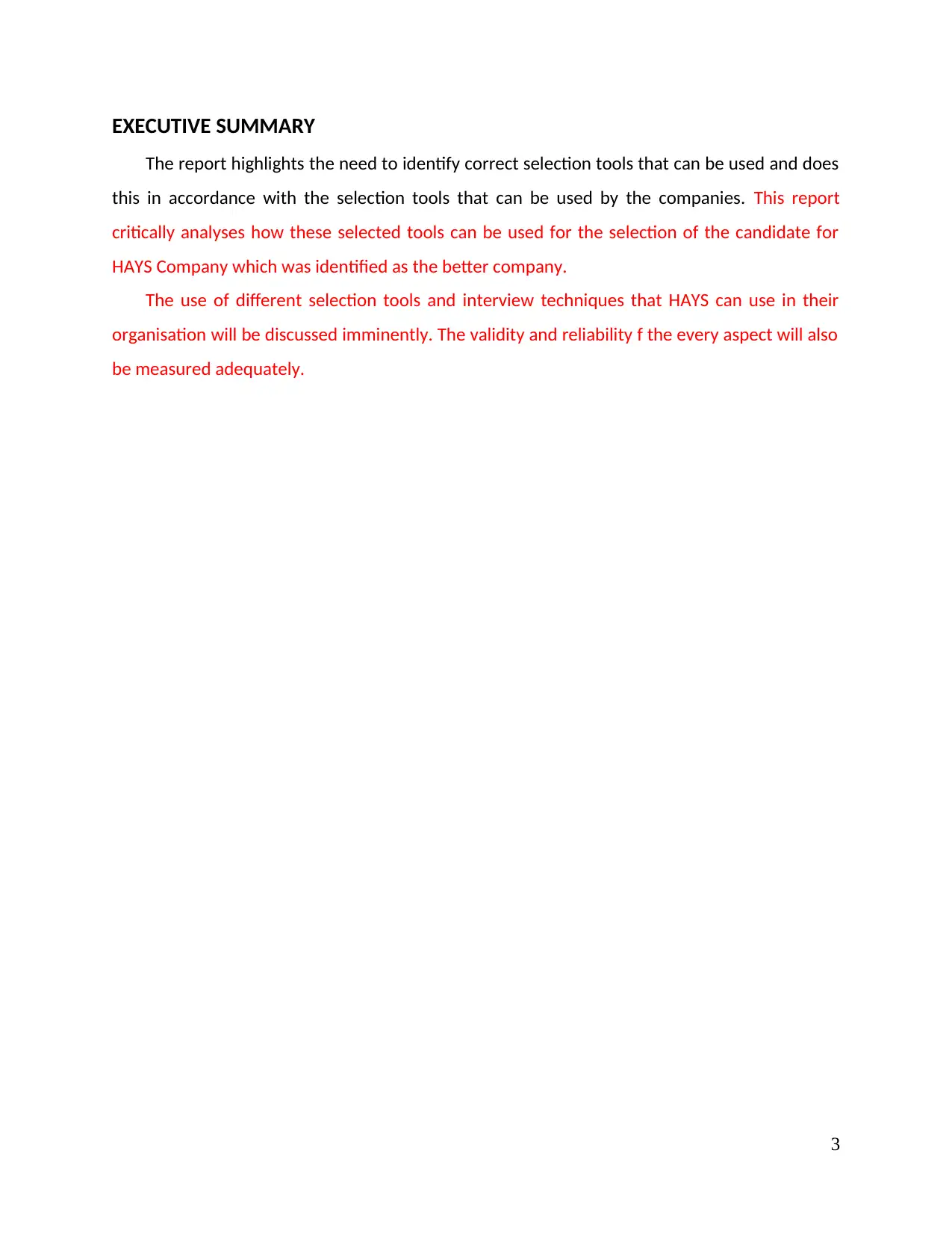
EXECUTIVE SUMMARY
The report highlights the need to identify correct selection tools that can be used and does
this in accordance with the selection tools that can be used by the companies. This report
critically analyses how these selected tools can be used for the selection of the candidate for
HAYS Company which was identified as the better company.
The use of different selection tools and interview techniques that HAYS can use in their
organisation will be discussed imminently. The validity and reliability f the every aspect will also
be measured adequately.
3
The report highlights the need to identify correct selection tools that can be used and does
this in accordance with the selection tools that can be used by the companies. This report
critically analyses how these selected tools can be used for the selection of the candidate for
HAYS Company which was identified as the better company.
The use of different selection tools and interview techniques that HAYS can use in their
organisation will be discussed imminently. The validity and reliability f the every aspect will also
be measured adequately.
3
⊘ This is a preview!⊘
Do you want full access?
Subscribe today to unlock all pages.

Trusted by 1+ million students worldwide
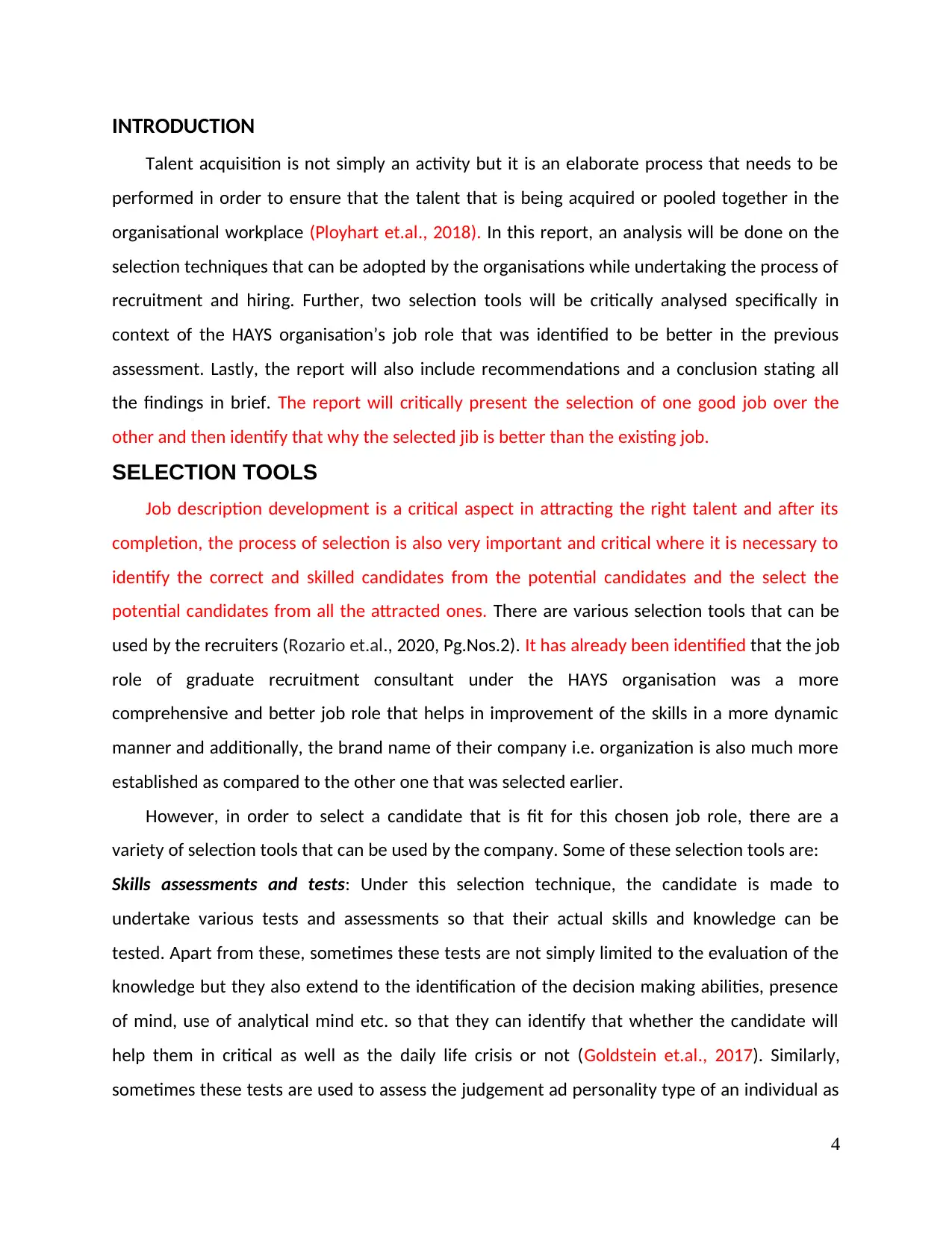
INTRODUCTION
Talent acquisition is not simply an activity but it is an elaborate process that needs to be
performed in order to ensure that the talent that is being acquired or pooled together in the
organisational workplace (Ployhart et.al., 2018). In this report, an analysis will be done on the
selection techniques that can be adopted by the organisations while undertaking the process of
recruitment and hiring. Further, two selection tools will be critically analysed specifically in
context of the HAYS organisation’s job role that was identified to be better in the previous
assessment. Lastly, the report will also include recommendations and a conclusion stating all
the findings in brief. The report will critically present the selection of one good job over the
other and then identify that why the selected jib is better than the existing job.
SELECTION TOOLS
Job description development is a critical aspect in attracting the right talent and after its
completion, the process of selection is also very important and critical where it is necessary to
identify the correct and skilled candidates from the potential candidates and the select the
potential candidates from all the attracted ones. There are various selection tools that can be
used by the recruiters (Rozario et.al., 2020, Pg.Nos.2). It has already been identified that the job
role of graduate recruitment consultant under the HAYS organisation was a more
comprehensive and better job role that helps in improvement of the skills in a more dynamic
manner and additionally, the brand name of their company i.e. organization is also much more
established as compared to the other one that was selected earlier.
However, in order to select a candidate that is fit for this chosen job role, there are a
variety of selection tools that can be used by the company. Some of these selection tools are:
Skills assessments and tests: Under this selection technique, the candidate is made to
undertake various tests and assessments so that their actual skills and knowledge can be
tested. Apart from these, sometimes these tests are not simply limited to the evaluation of the
knowledge but they also extend to the identification of the decision making abilities, presence
of mind, use of analytical mind etc. so that they can identify that whether the candidate will
help them in critical as well as the daily life crisis or not (Goldstein et.al., 2017). Similarly,
sometimes these tests are used to assess the judgement ad personality type of an individual as
4
Talent acquisition is not simply an activity but it is an elaborate process that needs to be
performed in order to ensure that the talent that is being acquired or pooled together in the
organisational workplace (Ployhart et.al., 2018). In this report, an analysis will be done on the
selection techniques that can be adopted by the organisations while undertaking the process of
recruitment and hiring. Further, two selection tools will be critically analysed specifically in
context of the HAYS organisation’s job role that was identified to be better in the previous
assessment. Lastly, the report will also include recommendations and a conclusion stating all
the findings in brief. The report will critically present the selection of one good job over the
other and then identify that why the selected jib is better than the existing job.
SELECTION TOOLS
Job description development is a critical aspect in attracting the right talent and after its
completion, the process of selection is also very important and critical where it is necessary to
identify the correct and skilled candidates from the potential candidates and the select the
potential candidates from all the attracted ones. There are various selection tools that can be
used by the recruiters (Rozario et.al., 2020, Pg.Nos.2). It has already been identified that the job
role of graduate recruitment consultant under the HAYS organisation was a more
comprehensive and better job role that helps in improvement of the skills in a more dynamic
manner and additionally, the brand name of their company i.e. organization is also much more
established as compared to the other one that was selected earlier.
However, in order to select a candidate that is fit for this chosen job role, there are a
variety of selection tools that can be used by the company. Some of these selection tools are:
Skills assessments and tests: Under this selection technique, the candidate is made to
undertake various tests and assessments so that their actual skills and knowledge can be
tested. Apart from these, sometimes these tests are not simply limited to the evaluation of the
knowledge but they also extend to the identification of the decision making abilities, presence
of mind, use of analytical mind etc. so that they can identify that whether the candidate will
help them in critical as well as the daily life crisis or not (Goldstein et.al., 2017). Similarly,
sometimes these tests are used to assess the judgement ad personality type of an individual as
4
Paraphrase This Document
Need a fresh take? Get an instant paraphrase of this document with our AI Paraphraser
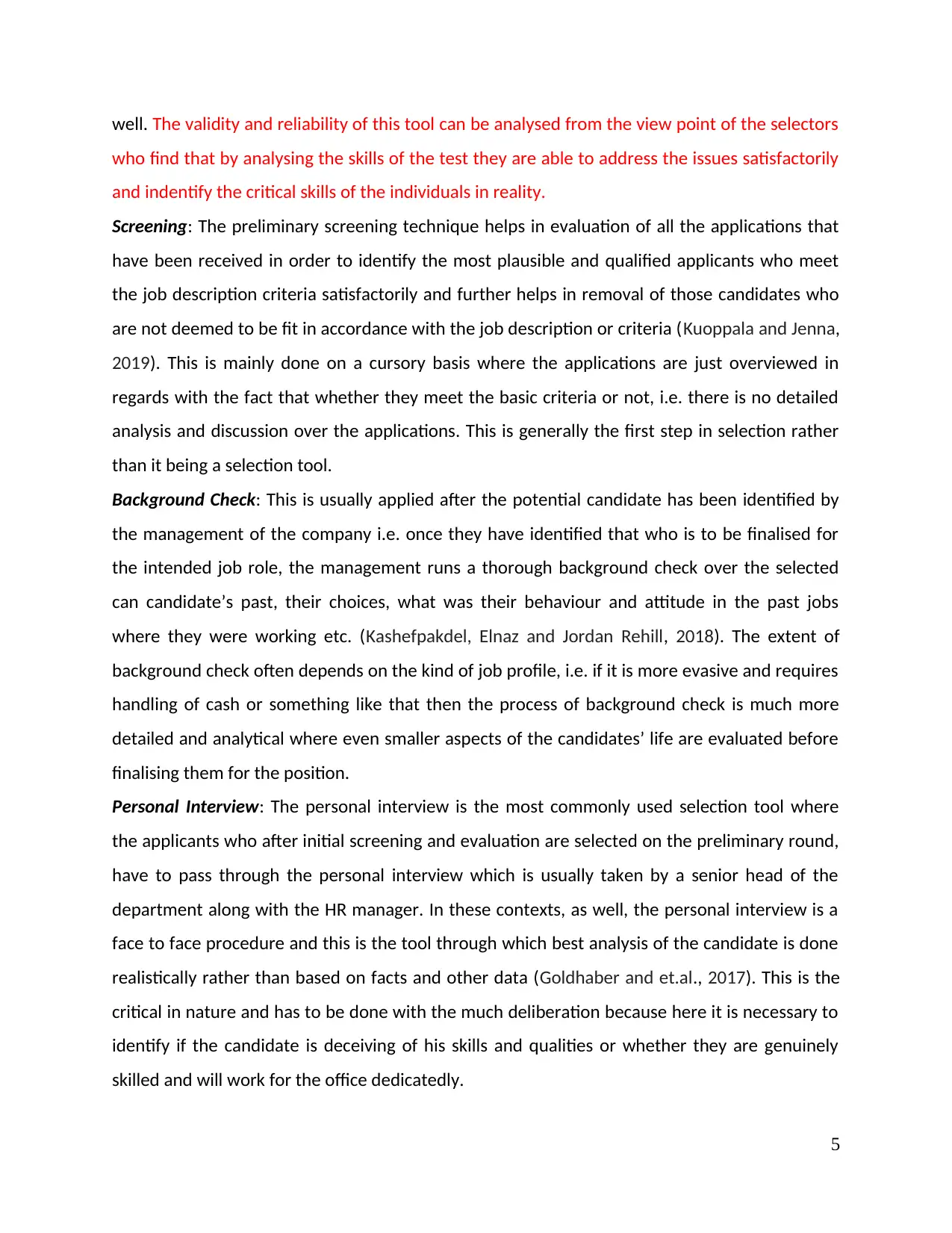
well. The validity and reliability of this tool can be analysed from the view point of the selectors
who find that by analysing the skills of the test they are able to address the issues satisfactorily
and indentify the critical skills of the individuals in reality.
Screening: The preliminary screening technique helps in evaluation of all the applications that
have been received in order to identify the most plausible and qualified applicants who meet
the job description criteria satisfactorily and further helps in removal of those candidates who
are not deemed to be fit in accordance with the job description or criteria (Kuoppala and Jenna,
2019). This is mainly done on a cursory basis where the applications are just overviewed in
regards with the fact that whether they meet the basic criteria or not, i.e. there is no detailed
analysis and discussion over the applications. This is generally the first step in selection rather
than it being a selection tool.
Background Check: This is usually applied after the potential candidate has been identified by
the management of the company i.e. once they have identified that who is to be finalised for
the intended job role, the management runs a thorough background check over the selected
can candidate’s past, their choices, what was their behaviour and attitude in the past jobs
where they were working etc. (Kashefpakdel, Elnaz and Jordan Rehill, 2018). The extent of
background check often depends on the kind of job profile, i.e. if it is more evasive and requires
handling of cash or something like that then the process of background check is much more
detailed and analytical where even smaller aspects of the candidates’ life are evaluated before
finalising them for the position.
Personal Interview: The personal interview is the most commonly used selection tool where
the applicants who after initial screening and evaluation are selected on the preliminary round,
have to pass through the personal interview which is usually taken by a senior head of the
department along with the HR manager. In these contexts, as well, the personal interview is a
face to face procedure and this is the tool through which best analysis of the candidate is done
realistically rather than based on facts and other data (Goldhaber and et.al., 2017). This is the
critical in nature and has to be done with the much deliberation because here it is necessary to
identify if the candidate is deceiving of his skills and qualities or whether they are genuinely
skilled and will work for the office dedicatedly.
5
who find that by analysing the skills of the test they are able to address the issues satisfactorily
and indentify the critical skills of the individuals in reality.
Screening: The preliminary screening technique helps in evaluation of all the applications that
have been received in order to identify the most plausible and qualified applicants who meet
the job description criteria satisfactorily and further helps in removal of those candidates who
are not deemed to be fit in accordance with the job description or criteria (Kuoppala and Jenna,
2019). This is mainly done on a cursory basis where the applications are just overviewed in
regards with the fact that whether they meet the basic criteria or not, i.e. there is no detailed
analysis and discussion over the applications. This is generally the first step in selection rather
than it being a selection tool.
Background Check: This is usually applied after the potential candidate has been identified by
the management of the company i.e. once they have identified that who is to be finalised for
the intended job role, the management runs a thorough background check over the selected
can candidate’s past, their choices, what was their behaviour and attitude in the past jobs
where they were working etc. (Kashefpakdel, Elnaz and Jordan Rehill, 2018). The extent of
background check often depends on the kind of job profile, i.e. if it is more evasive and requires
handling of cash or something like that then the process of background check is much more
detailed and analytical where even smaller aspects of the candidates’ life are evaluated before
finalising them for the position.
Personal Interview: The personal interview is the most commonly used selection tool where
the applicants who after initial screening and evaluation are selected on the preliminary round,
have to pass through the personal interview which is usually taken by a senior head of the
department along with the HR manager. In these contexts, as well, the personal interview is a
face to face procedure and this is the tool through which best analysis of the candidate is done
realistically rather than based on facts and other data (Goldhaber and et.al., 2017). This is the
critical in nature and has to be done with the much deliberation because here it is necessary to
identify if the candidate is deceiving of his skills and qualities or whether they are genuinely
skilled and will work for the office dedicatedly.
5
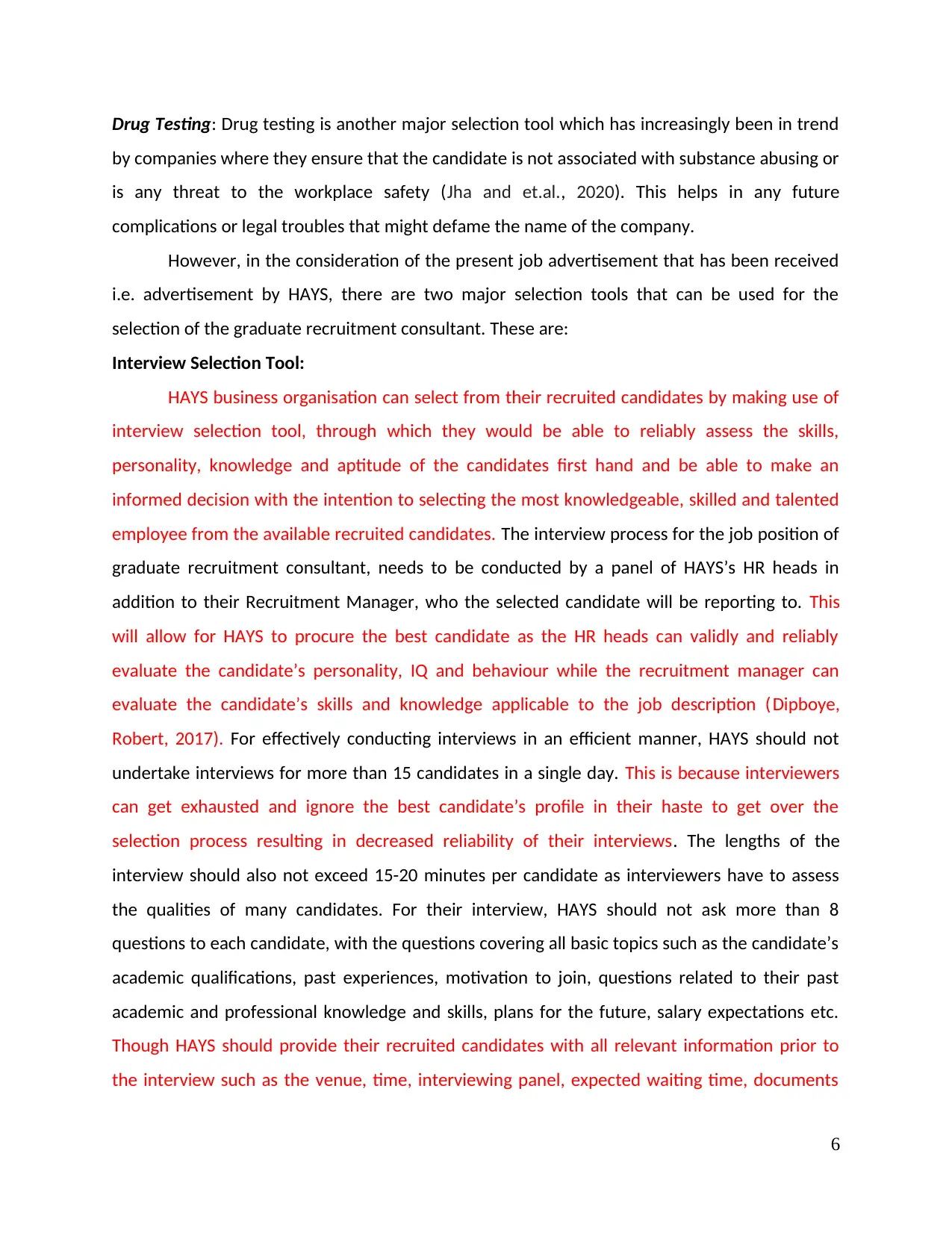
Drug Testing: Drug testing is another major selection tool which has increasingly been in trend
by companies where they ensure that the candidate is not associated with substance abusing or
is any threat to the workplace safety (Jha and et.al., 2020). This helps in any future
complications or legal troubles that might defame the name of the company.
However, in the consideration of the present job advertisement that has been received
i.e. advertisement by HAYS, there are two major selection tools that can be used for the
selection of the graduate recruitment consultant. These are:
Interview Selection Tool:
HAYS business organisation can select from their recruited candidates by making use of
interview selection tool, through which they would be able to reliably assess the skills,
personality, knowledge and aptitude of the candidates first hand and be able to make an
informed decision with the intention to selecting the most knowledgeable, skilled and talented
employee from the available recruited candidates. The interview process for the job position of
graduate recruitment consultant, needs to be conducted by a panel of HAYS’s HR heads in
addition to their Recruitment Manager, who the selected candidate will be reporting to. This
will allow for HAYS to procure the best candidate as the HR heads can validly and reliably
evaluate the candidate’s personality, IQ and behaviour while the recruitment manager can
evaluate the candidate’s skills and knowledge applicable to the job description (Dipboye,
Robert, 2017). For effectively conducting interviews in an efficient manner, HAYS should not
undertake interviews for more than 15 candidates in a single day. This is because interviewers
can get exhausted and ignore the best candidate’s profile in their haste to get over the
selection process resulting in decreased reliability of their interviews. The lengths of the
interview should also not exceed 15-20 minutes per candidate as interviewers have to assess
the qualities of many candidates. For their interview, HAYS should not ask more than 8
questions to each candidate, with the questions covering all basic topics such as the candidate’s
academic qualifications, past experiences, motivation to join, questions related to their past
academic and professional knowledge and skills, plans for the future, salary expectations etc.
Though HAYS should provide their recruited candidates with all relevant information prior to
the interview such as the venue, time, interviewing panel, expected waiting time, documents
6
by companies where they ensure that the candidate is not associated with substance abusing or
is any threat to the workplace safety (Jha and et.al., 2020). This helps in any future
complications or legal troubles that might defame the name of the company.
However, in the consideration of the present job advertisement that has been received
i.e. advertisement by HAYS, there are two major selection tools that can be used for the
selection of the graduate recruitment consultant. These are:
Interview Selection Tool:
HAYS business organisation can select from their recruited candidates by making use of
interview selection tool, through which they would be able to reliably assess the skills,
personality, knowledge and aptitude of the candidates first hand and be able to make an
informed decision with the intention to selecting the most knowledgeable, skilled and talented
employee from the available recruited candidates. The interview process for the job position of
graduate recruitment consultant, needs to be conducted by a panel of HAYS’s HR heads in
addition to their Recruitment Manager, who the selected candidate will be reporting to. This
will allow for HAYS to procure the best candidate as the HR heads can validly and reliably
evaluate the candidate’s personality, IQ and behaviour while the recruitment manager can
evaluate the candidate’s skills and knowledge applicable to the job description (Dipboye,
Robert, 2017). For effectively conducting interviews in an efficient manner, HAYS should not
undertake interviews for more than 15 candidates in a single day. This is because interviewers
can get exhausted and ignore the best candidate’s profile in their haste to get over the
selection process resulting in decreased reliability of their interviews. The lengths of the
interview should also not exceed 15-20 minutes per candidate as interviewers have to assess
the qualities of many candidates. For their interview, HAYS should not ask more than 8
questions to each candidate, with the questions covering all basic topics such as the candidate’s
academic qualifications, past experiences, motivation to join, questions related to their past
academic and professional knowledge and skills, plans for the future, salary expectations etc.
Though HAYS should provide their recruited candidates with all relevant information prior to
the interview such as the venue, time, interviewing panel, expected waiting time, documents
6
⊘ This is a preview!⊘
Do you want full access?
Subscribe today to unlock all pages.

Trusted by 1+ million students worldwide
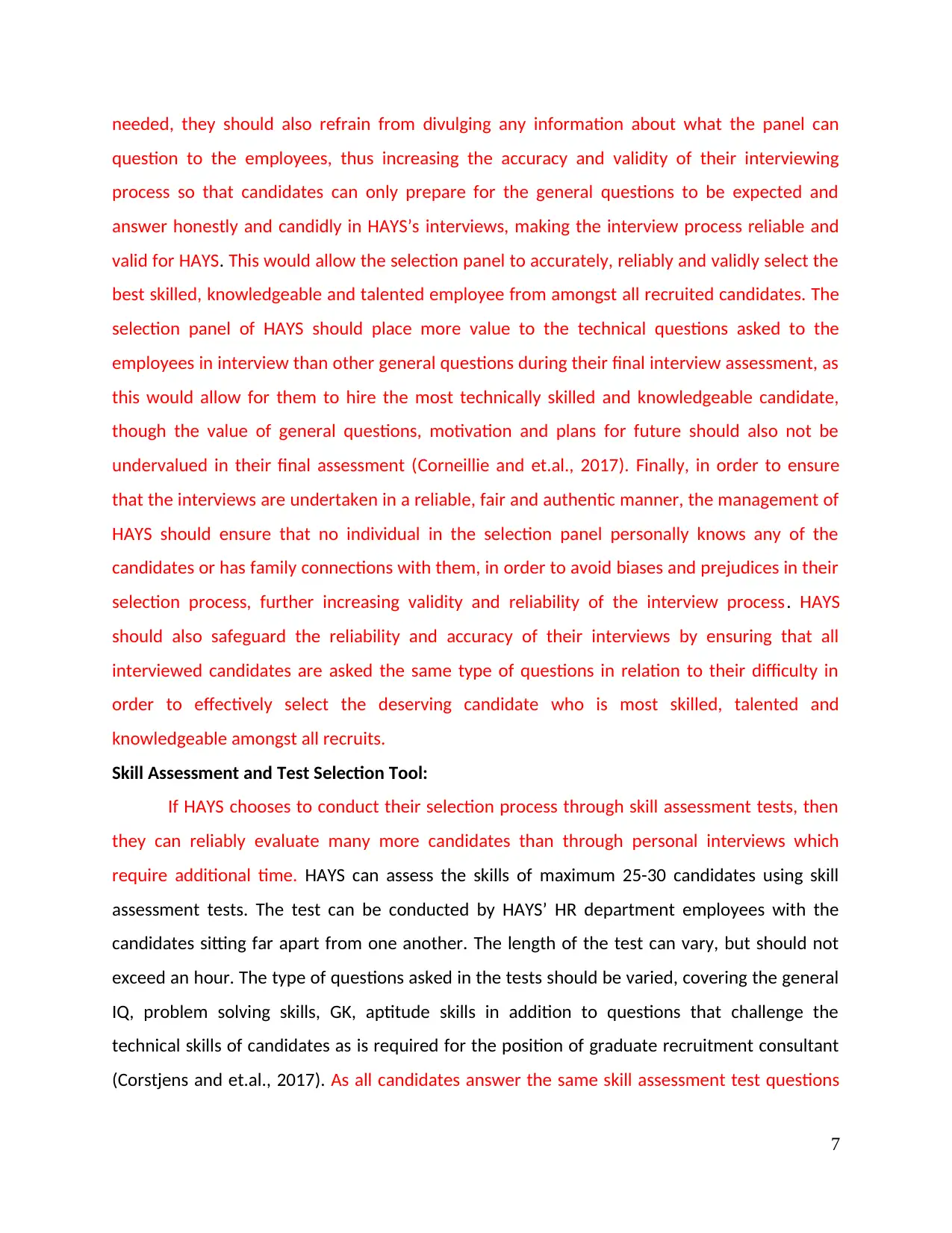
needed, they should also refrain from divulging any information about what the panel can
question to the employees, thus increasing the accuracy and validity of their interviewing
process so that candidates can only prepare for the general questions to be expected and
answer honestly and candidly in HAYS’s interviews, making the interview process reliable and
valid for HAYS. This would allow the selection panel to accurately, reliably and validly select the
best skilled, knowledgeable and talented employee from amongst all recruited candidates. The
selection panel of HAYS should place more value to the technical questions asked to the
employees in interview than other general questions during their final interview assessment, as
this would allow for them to hire the most technically skilled and knowledgeable candidate,
though the value of general questions, motivation and plans for future should also not be
undervalued in their final assessment (Corneillie and et.al., 2017). Finally, in order to ensure
that the interviews are undertaken in a reliable, fair and authentic manner, the management of
HAYS should ensure that no individual in the selection panel personally knows any of the
candidates or has family connections with them, in order to avoid biases and prejudices in their
selection process, further increasing validity and reliability of the interview process. HAYS
should also safeguard the reliability and accuracy of their interviews by ensuring that all
interviewed candidates are asked the same type of questions in relation to their difficulty in
order to effectively select the deserving candidate who is most skilled, talented and
knowledgeable amongst all recruits.
Skill Assessment and Test Selection Tool:
If HAYS chooses to conduct their selection process through skill assessment tests, then
they can reliably evaluate many more candidates than through personal interviews which
require additional time. HAYS can assess the skills of maximum 25-30 candidates using skill
assessment tests. The test can be conducted by HAYS’ HR department employees with the
candidates sitting far apart from one another. The length of the test can vary, but should not
exceed an hour. The type of questions asked in the tests should be varied, covering the general
IQ, problem solving skills, GK, aptitude skills in addition to questions that challenge the
technical skills of candidates as is required for the position of graduate recruitment consultant
(Corstjens and et.al., 2017). As all candidates answer the same skill assessment test questions
7
question to the employees, thus increasing the accuracy and validity of their interviewing
process so that candidates can only prepare for the general questions to be expected and
answer honestly and candidly in HAYS’s interviews, making the interview process reliable and
valid for HAYS. This would allow the selection panel to accurately, reliably and validly select the
best skilled, knowledgeable and talented employee from amongst all recruited candidates. The
selection panel of HAYS should place more value to the technical questions asked to the
employees in interview than other general questions during their final interview assessment, as
this would allow for them to hire the most technically skilled and knowledgeable candidate,
though the value of general questions, motivation and plans for future should also not be
undervalued in their final assessment (Corneillie and et.al., 2017). Finally, in order to ensure
that the interviews are undertaken in a reliable, fair and authentic manner, the management of
HAYS should ensure that no individual in the selection panel personally knows any of the
candidates or has family connections with them, in order to avoid biases and prejudices in their
selection process, further increasing validity and reliability of the interview process. HAYS
should also safeguard the reliability and accuracy of their interviews by ensuring that all
interviewed candidates are asked the same type of questions in relation to their difficulty in
order to effectively select the deserving candidate who is most skilled, talented and
knowledgeable amongst all recruits.
Skill Assessment and Test Selection Tool:
If HAYS chooses to conduct their selection process through skill assessment tests, then
they can reliably evaluate many more candidates than through personal interviews which
require additional time. HAYS can assess the skills of maximum 25-30 candidates using skill
assessment tests. The test can be conducted by HAYS’ HR department employees with the
candidates sitting far apart from one another. The length of the test can vary, but should not
exceed an hour. The type of questions asked in the tests should be varied, covering the general
IQ, problem solving skills, GK, aptitude skills in addition to questions that challenge the
technical skills of candidates as is required for the position of graduate recruitment consultant
(Corstjens and et.al., 2017). As all candidates answer the same skill assessment test questions
7
Paraphrase This Document
Need a fresh take? Get an instant paraphrase of this document with our AI Paraphraser
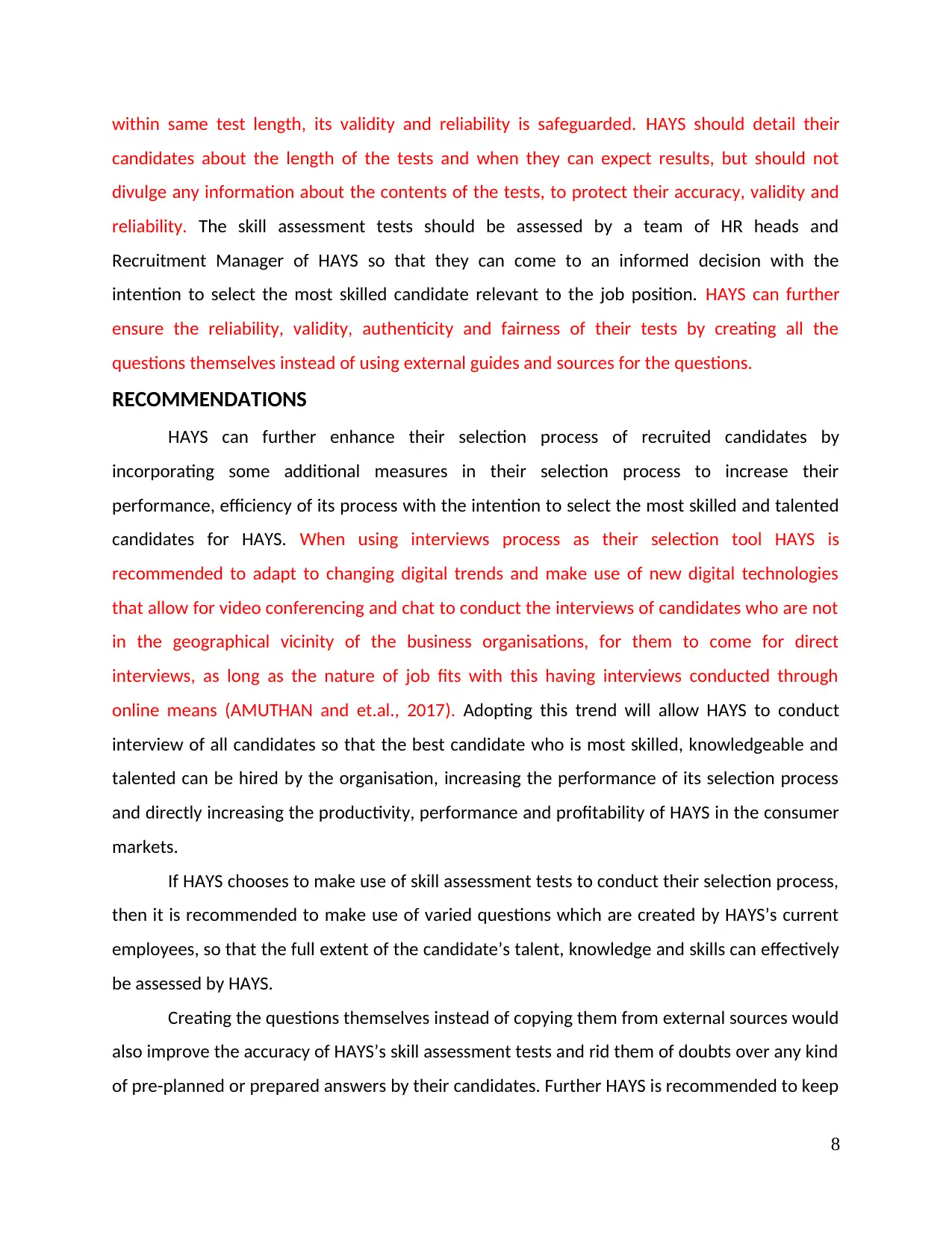
within same test length, its validity and reliability is safeguarded. HAYS should detail their
candidates about the length of the tests and when they can expect results, but should not
divulge any information about the contents of the tests, to protect their accuracy, validity and
reliability. The skill assessment tests should be assessed by a team of HR heads and
Recruitment Manager of HAYS so that they can come to an informed decision with the
intention to select the most skilled candidate relevant to the job position. HAYS can further
ensure the reliability, validity, authenticity and fairness of their tests by creating all the
questions themselves instead of using external guides and sources for the questions.
RECOMMENDATIONS
HAYS can further enhance their selection process of recruited candidates by
incorporating some additional measures in their selection process to increase their
performance, efficiency of its process with the intention to select the most skilled and talented
candidates for HAYS. When using interviews process as their selection tool HAYS is
recommended to adapt to changing digital trends and make use of new digital technologies
that allow for video conferencing and chat to conduct the interviews of candidates who are not
in the geographical vicinity of the business organisations, for them to come for direct
interviews, as long as the nature of job fits with this having interviews conducted through
online means (AMUTHAN and et.al., 2017). Adopting this trend will allow HAYS to conduct
interview of all candidates so that the best candidate who is most skilled, knowledgeable and
talented can be hired by the organisation, increasing the performance of its selection process
and directly increasing the productivity, performance and profitability of HAYS in the consumer
markets.
If HAYS chooses to make use of skill assessment tests to conduct their selection process,
then it is recommended to make use of varied questions which are created by HAYS’s current
employees, so that the full extent of the candidate’s talent, knowledge and skills can effectively
be assessed by HAYS.
Creating the questions themselves instead of copying them from external sources would
also improve the accuracy of HAYS’s skill assessment tests and rid them of doubts over any kind
of pre-planned or prepared answers by their candidates. Further HAYS is recommended to keep
8
candidates about the length of the tests and when they can expect results, but should not
divulge any information about the contents of the tests, to protect their accuracy, validity and
reliability. The skill assessment tests should be assessed by a team of HR heads and
Recruitment Manager of HAYS so that they can come to an informed decision with the
intention to select the most skilled candidate relevant to the job position. HAYS can further
ensure the reliability, validity, authenticity and fairness of their tests by creating all the
questions themselves instead of using external guides and sources for the questions.
RECOMMENDATIONS
HAYS can further enhance their selection process of recruited candidates by
incorporating some additional measures in their selection process to increase their
performance, efficiency of its process with the intention to select the most skilled and talented
candidates for HAYS. When using interviews process as their selection tool HAYS is
recommended to adapt to changing digital trends and make use of new digital technologies
that allow for video conferencing and chat to conduct the interviews of candidates who are not
in the geographical vicinity of the business organisations, for them to come for direct
interviews, as long as the nature of job fits with this having interviews conducted through
online means (AMUTHAN and et.al., 2017). Adopting this trend will allow HAYS to conduct
interview of all candidates so that the best candidate who is most skilled, knowledgeable and
talented can be hired by the organisation, increasing the performance of its selection process
and directly increasing the productivity, performance and profitability of HAYS in the consumer
markets.
If HAYS chooses to make use of skill assessment tests to conduct their selection process,
then it is recommended to make use of varied questions which are created by HAYS’s current
employees, so that the full extent of the candidate’s talent, knowledge and skills can effectively
be assessed by HAYS.
Creating the questions themselves instead of copying them from external sources would
also improve the accuracy of HAYS’s skill assessment tests and rid them of doubts over any kind
of pre-planned or prepared answers by their candidates. Further HAYS is recommended to keep
8
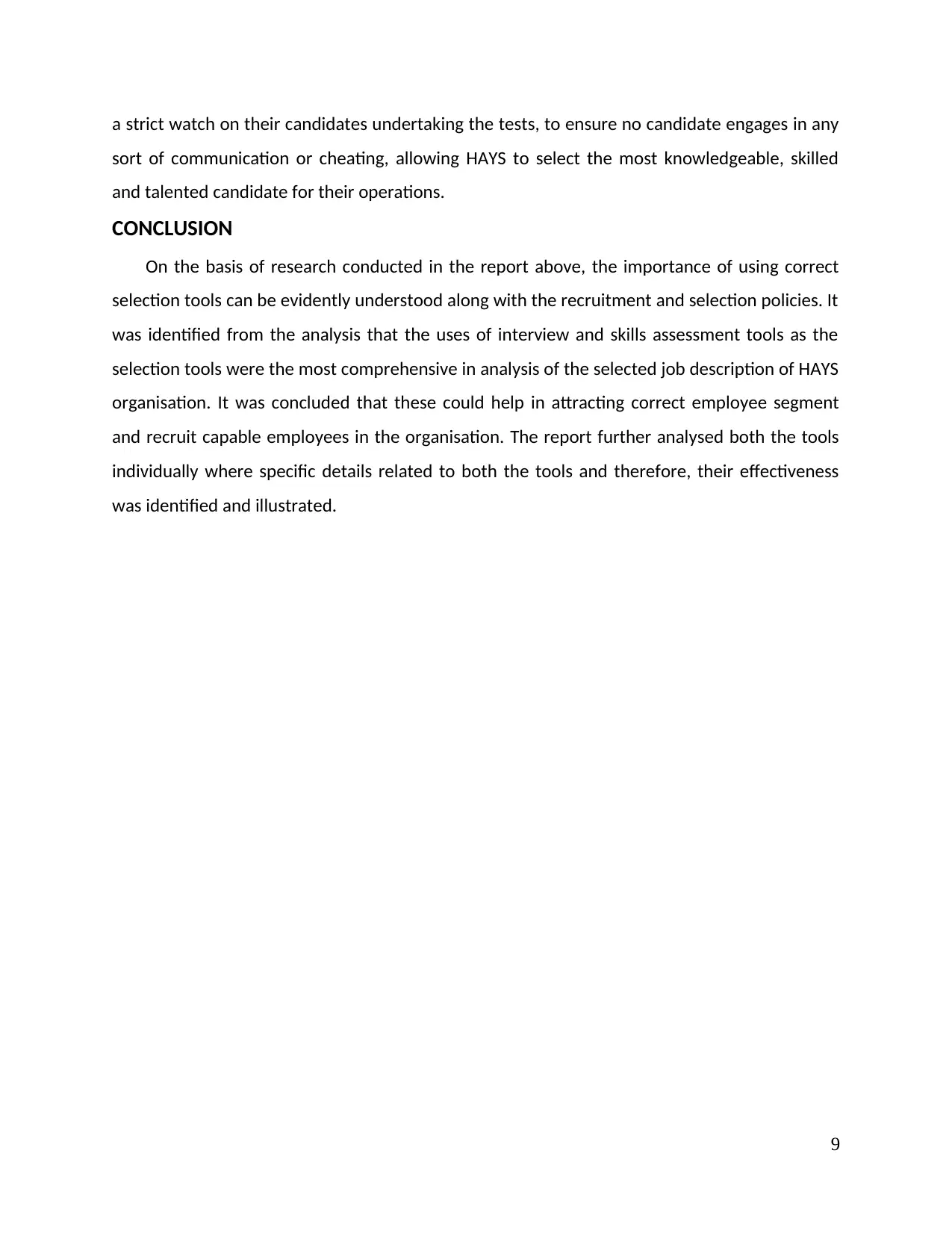
a strict watch on their candidates undertaking the tests, to ensure no candidate engages in any
sort of communication or cheating, allowing HAYS to select the most knowledgeable, skilled
and talented candidate for their operations.
CONCLUSION
On the basis of research conducted in the report above, the importance of using correct
selection tools can be evidently understood along with the recruitment and selection policies. It
was identified from the analysis that the uses of interview and skills assessment tools as the
selection tools were the most comprehensive in analysis of the selected job description of HAYS
organisation. It was concluded that these could help in attracting correct employee segment
and recruit capable employees in the organisation. The report further analysed both the tools
individually where specific details related to both the tools and therefore, their effectiveness
was identified and illustrated.
9
sort of communication or cheating, allowing HAYS to select the most knowledgeable, skilled
and talented candidate for their operations.
CONCLUSION
On the basis of research conducted in the report above, the importance of using correct
selection tools can be evidently understood along with the recruitment and selection policies. It
was identified from the analysis that the uses of interview and skills assessment tools as the
selection tools were the most comprehensive in analysis of the selected job description of HAYS
organisation. It was concluded that these could help in attracting correct employee segment
and recruit capable employees in the organisation. The report further analysed both the tools
individually where specific details related to both the tools and therefore, their effectiveness
was identified and illustrated.
9
⊘ This is a preview!⊘
Do you want full access?
Subscribe today to unlock all pages.

Trusted by 1+ million students worldwide
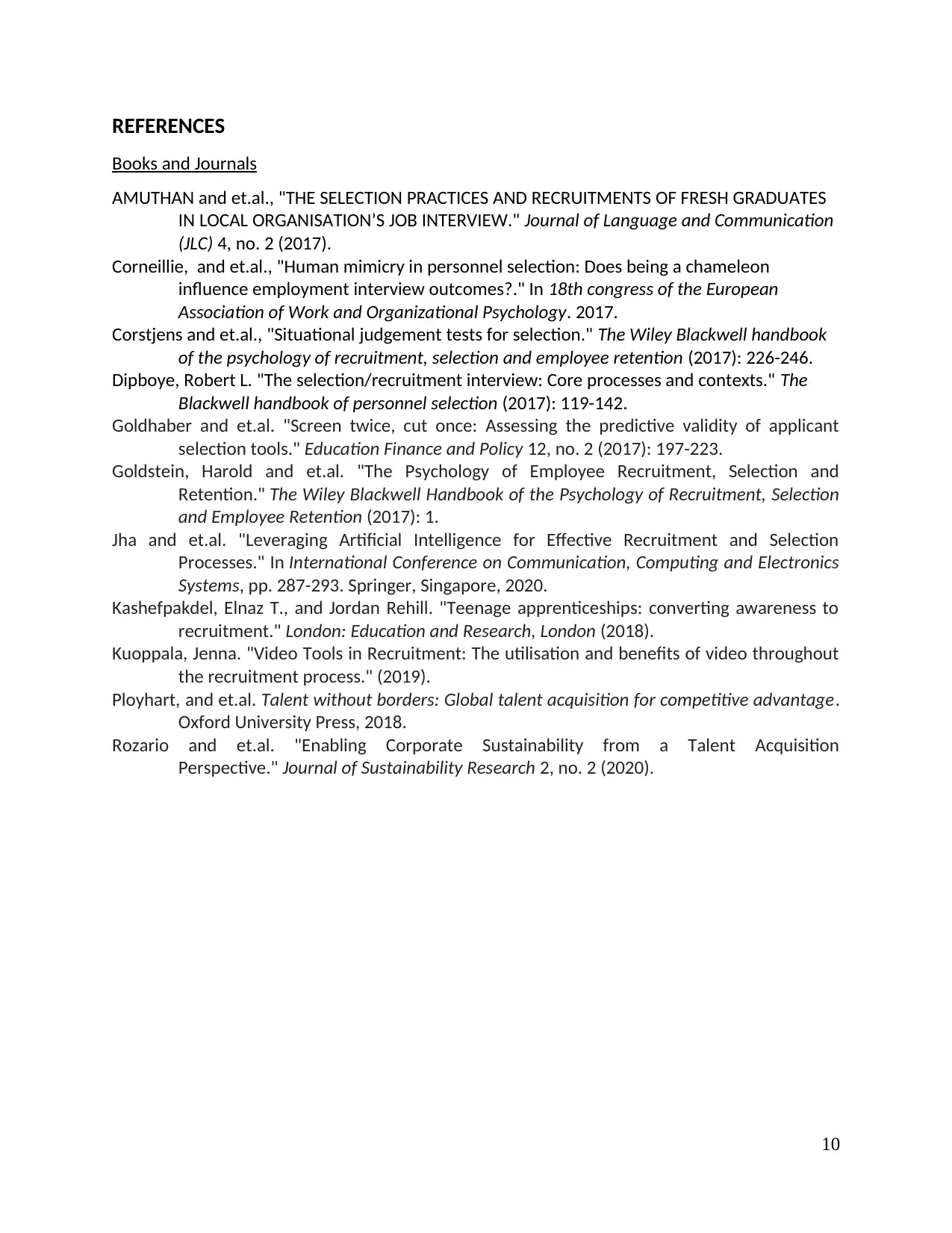
REFERENCES
Books and Journals
AMUTHAN and et.al., "THE SELECTION PRACTICES AND RECRUITMENTS OF FRESH GRADUATES
IN LOCAL ORGANISATION’S JOB INTERVIEW." Journal of Language and Communication
(JLC) 4, no. 2 (2017).
Corneillie, and et.al., "Human mimicry in personnel selection: Does being a chameleon
influence employment interview outcomes?." In 18th congress of the European
Association of Work and Organizational Psychology. 2017.
Corstjens and et.al., "Situational judgement tests for selection." The Wiley Blackwell handbook
of the psychology of recruitment, selection and employee retention (2017): 226-246.
Dipboye, Robert L. "The selection/recruitment interview: Core processes and contexts." The
Blackwell handbook of personnel selection (2017): 119-142.
Goldhaber and et.al. "Screen twice, cut once: Assessing the predictive validity of applicant
selection tools." Education Finance and Policy 12, no. 2 (2017): 197-223.
Goldstein, Harold and et.al. "The Psychology of Employee Recruitment, Selection and
Retention." The Wiley Blackwell Handbook of the Psychology of Recruitment, Selection
and Employee Retention (2017): 1.
Jha and et.al. "Leveraging Artificial Intelligence for Effective Recruitment and Selection
Processes." In International Conference on Communication, Computing and Electronics
Systems, pp. 287-293. Springer, Singapore, 2020.
Kashefpakdel, Elnaz T., and Jordan Rehill. "Teenage apprenticeships: converting awareness to
recruitment." London: Education and Research, London (2018).
Kuoppala, Jenna. "Video Tools in Recruitment: The utilisation and benefits of video throughout
the recruitment process." (2019).
Ployhart, and et.al. Talent without borders: Global talent acquisition for competitive advantage.
Oxford University Press, 2018.
Rozario and et.al. "Enabling Corporate Sustainability from a Talent Acquisition
Perspective." Journal of Sustainability Research 2, no. 2 (2020).
10
Books and Journals
AMUTHAN and et.al., "THE SELECTION PRACTICES AND RECRUITMENTS OF FRESH GRADUATES
IN LOCAL ORGANISATION’S JOB INTERVIEW." Journal of Language and Communication
(JLC) 4, no. 2 (2017).
Corneillie, and et.al., "Human mimicry in personnel selection: Does being a chameleon
influence employment interview outcomes?." In 18th congress of the European
Association of Work and Organizational Psychology. 2017.
Corstjens and et.al., "Situational judgement tests for selection." The Wiley Blackwell handbook
of the psychology of recruitment, selection and employee retention (2017): 226-246.
Dipboye, Robert L. "The selection/recruitment interview: Core processes and contexts." The
Blackwell handbook of personnel selection (2017): 119-142.
Goldhaber and et.al. "Screen twice, cut once: Assessing the predictive validity of applicant
selection tools." Education Finance and Policy 12, no. 2 (2017): 197-223.
Goldstein, Harold and et.al. "The Psychology of Employee Recruitment, Selection and
Retention." The Wiley Blackwell Handbook of the Psychology of Recruitment, Selection
and Employee Retention (2017): 1.
Jha and et.al. "Leveraging Artificial Intelligence for Effective Recruitment and Selection
Processes." In International Conference on Communication, Computing and Electronics
Systems, pp. 287-293. Springer, Singapore, 2020.
Kashefpakdel, Elnaz T., and Jordan Rehill. "Teenage apprenticeships: converting awareness to
recruitment." London: Education and Research, London (2018).
Kuoppala, Jenna. "Video Tools in Recruitment: The utilisation and benefits of video throughout
the recruitment process." (2019).
Ployhart, and et.al. Talent without borders: Global talent acquisition for competitive advantage.
Oxford University Press, 2018.
Rozario and et.al. "Enabling Corporate Sustainability from a Talent Acquisition
Perspective." Journal of Sustainability Research 2, no. 2 (2020).
10
Paraphrase This Document
Need a fresh take? Get an instant paraphrase of this document with our AI Paraphraser
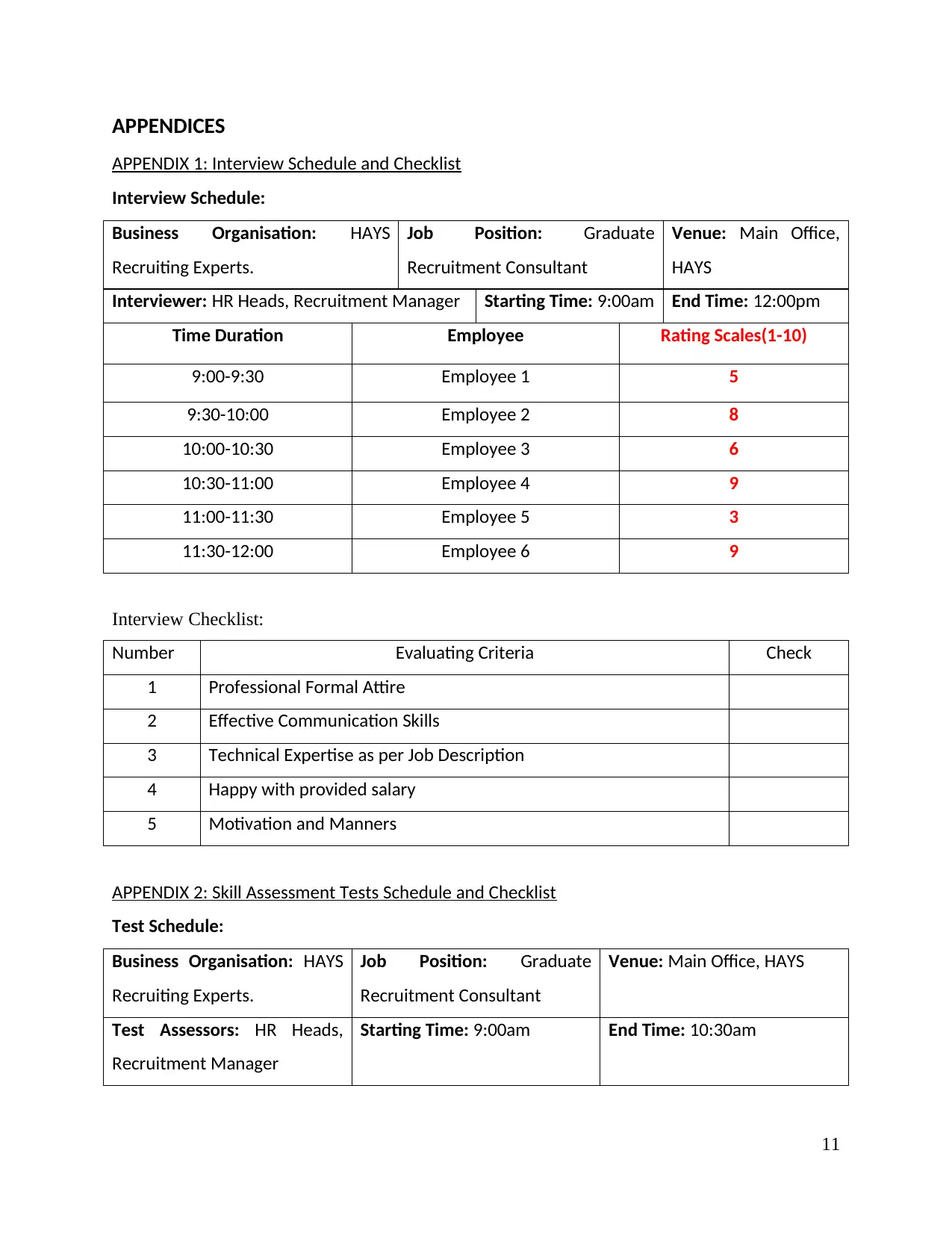
APPENDICES
APPENDIX 1: Interview Schedule and Checklist
Interview Schedule:
Business Organisation: HAYS
Recruiting Experts.
Job Position: Graduate
Recruitment Consultant
Venue: Main Office,
HAYS
Interviewer: HR Heads, Recruitment Manager Starting Time: 9:00am End Time: 12:00pm
Time Duration Employee Rating Scales(1-10)
9:00-9:30 Employee 1 5
9:30-10:00 Employee 2 8
10:00-10:30 Employee 3 6
10:30-11:00 Employee 4 9
11:00-11:30 Employee 5 3
11:30-12:00 Employee 6 9
Interview Checklist:
Number Evaluating Criteria Check
1 Professional Formal Attire
2 Effective Communication Skills
3 Technical Expertise as per Job Description
4 Happy with provided salary
5 Motivation and Manners
APPENDIX 2: Skill Assessment Tests Schedule and Checklist
Test Schedule:
Business Organisation: HAYS
Recruiting Experts.
Job Position: Graduate
Recruitment Consultant
Venue: Main Office, HAYS
Test Assessors: HR Heads,
Recruitment Manager
Starting Time: 9:00am End Time: 10:30am
11
APPENDIX 1: Interview Schedule and Checklist
Interview Schedule:
Business Organisation: HAYS
Recruiting Experts.
Job Position: Graduate
Recruitment Consultant
Venue: Main Office,
HAYS
Interviewer: HR Heads, Recruitment Manager Starting Time: 9:00am End Time: 12:00pm
Time Duration Employee Rating Scales(1-10)
9:00-9:30 Employee 1 5
9:30-10:00 Employee 2 8
10:00-10:30 Employee 3 6
10:30-11:00 Employee 4 9
11:00-11:30 Employee 5 3
11:30-12:00 Employee 6 9
Interview Checklist:
Number Evaluating Criteria Check
1 Professional Formal Attire
2 Effective Communication Skills
3 Technical Expertise as per Job Description
4 Happy with provided salary
5 Motivation and Manners
APPENDIX 2: Skill Assessment Tests Schedule and Checklist
Test Schedule:
Business Organisation: HAYS
Recruiting Experts.
Job Position: Graduate
Recruitment Consultant
Venue: Main Office, HAYS
Test Assessors: HR Heads,
Recruitment Manager
Starting Time: 9:00am End Time: 10:30am
11
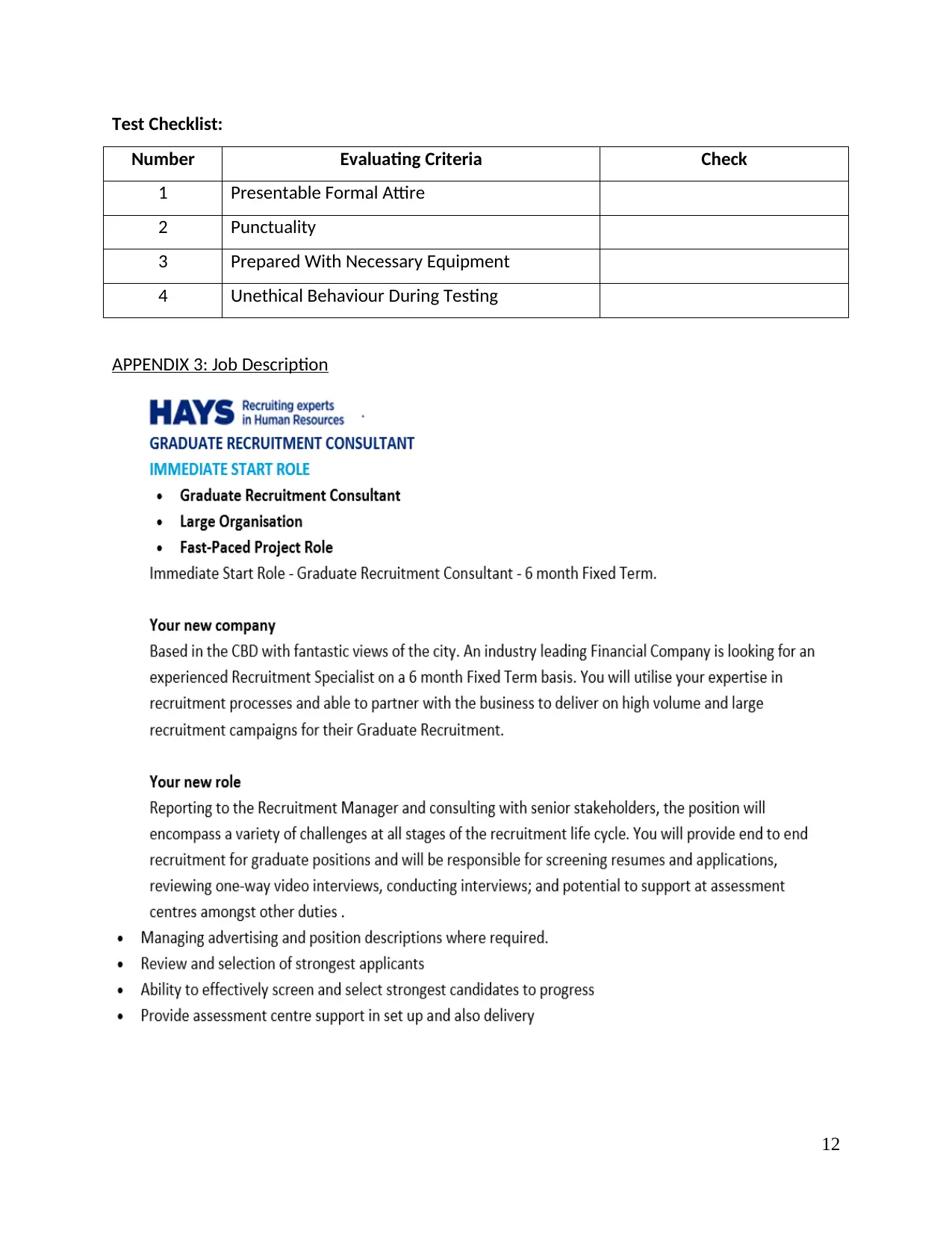
Test Checklist:
Number Evaluating Criteria Check
1 Presentable Formal Attire
2 Punctuality
3 Prepared With Necessary Equipment
4 Unethical Behaviour During Testing
APPENDIX 3: Job Description
12
Number Evaluating Criteria Check
1 Presentable Formal Attire
2 Punctuality
3 Prepared With Necessary Equipment
4 Unethical Behaviour During Testing
APPENDIX 3: Job Description
12
⊘ This is a preview!⊘
Do you want full access?
Subscribe today to unlock all pages.

Trusted by 1+ million students worldwide
1 out of 15
Related Documents
Your All-in-One AI-Powered Toolkit for Academic Success.
+13062052269
info@desklib.com
Available 24*7 on WhatsApp / Email
![[object Object]](/_next/static/media/star-bottom.7253800d.svg)
Unlock your academic potential
Copyright © 2020–2025 A2Z Services. All Rights Reserved. Developed and managed by ZUCOL.





